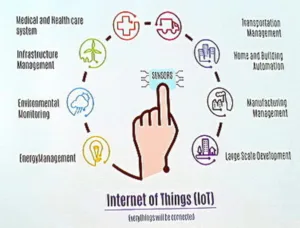InfoComm International hosted an all day seminar on September 8th on the relationship between the Internet of Things (IoT) and professional audio-video (pro AV) titled IoT Insights. While there was no hard news at the seminar, it did provide, as promised, considerable insight into the future of pro AV.
The seminar was part of the InfoComm education program and the main target was working members of the pro AV community and InfoComm provided 4 points toward a Certified Technology Specialist (CTS) certification, including CTS-D (Design) or CTS-I (Installation).
Much of the IoT press coverage has been related to Smart Homes, including thermostats, door locks, lighting and security systems that can be connected to the Internet and then monitored and controlled from anywhere in the world. According to InfoComm International, the IoT is much more than this and will be a $19 trillion business over the next 10 years.
Sensors are the key to the IoT and the speakers focused on sensors that are important to the Pro AV community. These included sensors that have long been a part of Pro AV, including motion sensors in rooms, thermal sensors inside projectors and flat panel displays, lamp life sensors, ambient light sensors, etc. Sensors that have not always been a part of Pro AV but obviously have application to the business include things like temperature sensors inside AV equipment racks. There are also sensors that have not been so much a part of AV in the past, such as building and room access control.
The sensors are the eyes and ears of the system and provide inputs to the control systems. Window shade and lighting controls have been a part of a pro AV installation for a long time, but now the “Projector On” sensor and the “Ambient Light” sensor can control the shades, lowering the shades when the projector is on and adjusting the lighting so no light is directly on the projection screen and overall lighting is dimmed to note-taking levels when a PowerPoint deck is shown. Light levels can automatically be dimmed further when video content is shown and raised again when the PowerPoint comes back on the screen. This can eliminate hoots from the audience of “Dim the lights!”, common when a person fails to do this when he should.
More and more pro AV integrators are focusing on service rather than the initial installation in a “Razors and razor blade” business model. This can mean anticipating problems rather than reacting to them. For example, when the building architect fails to install proper ventilation in an equipment bay or when that ventilator fails, the AV integrator remotely monitoring the temperature in a equipment rack can see the temperature rise out of limits. If the building owner refuses to fix the problem, this can void the warranty on the installed AV equipment in the rack.
Security and access controls and also interface with the AV system. For example, one speaker spoke of a college that encouraged students to use classrooms as study spaces and allowed student IDs to unlock classroom doors. The control system did not allow students to use the installed AV equipment in the classroom; it was not activated until a professor logged into the room.
Much of this is very familiar: familiar to the equipment suppliers, the seminar speakers and, for that matter, to me. One of the speakers said the pro AV community has been using IoT technology for 10 years or more – since before the name “IoT” was invented. Kramer was a premier sponsor of both this event and of InfoComm International overall and Crestron was a silver sponsor of this event. While Kramer and Crestron haven’t used the term “Internet of Things” to describe their AV control systems it the past, that is exactly what they are. Sensors, controllers, displays and other devices dedicated to simplifying AV installation and subsequent AV tasks. In the past, some of these units had dedicated, non-Internet connectors but these antique connections such as RS-232 have rapidly given way to the nearly universal RJ45 Ethernet connector, which in turn is losing some market share to wireless connections. Pro AV is going digital and it takes a lot of software to make it work. In fact, in many cases, the AV components are just black boxes to be bought. The maze of cables formerly a standard part of a major AV installation is being replaced by a maze of software to tie the black boxes together.
 Gary Hall discussed the pervasiveness of connected systems.
Gary Hall discussed the pervasiveness of connected systems.
This ongoing AV shift from hardware to software is recognized by InfoComm International, all the speakers at this seminar, Kramer, Crestron and their competitors and other suppliers in the industry. Gary Hall; CTS-D, CTS-I; Federal Strategy Planning & Operations at Cisco Systems; and President-Elect of the InfoComm International Board of Directors, estimated that the time to major disruption in the AV industry is about 3 years. Based on disruptions in other industries, he said 4 out of 10 market leaders will see dramatic losses of market share. But is this pending disruption recognized by the typical AV worker? I was talking to one over lunch at this seminar, asking him what he thought about pro AV being subsumed into the IT world. He didn’t believe it would happen. “Pro AV people know how to make things work but IT people don’t.”
Huh? This would be news to the billions of IT end users world-wide whose IT-system-in-a-pocket (AKA smartphone) works every time they push the “send” button so this gentleman may be in for a rude surprise. Since he was at the IoT seminar, he won’t even be able to say he wasn’t warned. –Matthew Brennesholtz

